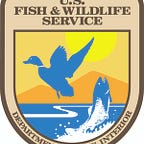New Year, New Passage for Threatened Bull Trout
Authors: Steve Lewis, FWS Fish and Wildlife Biologist, Washington Fish and Wildlife Office; and Richard Visser and Scott Willey, U.S. Bureau of Reclamation
My family always asks me, “So Steve, what interesting projects are you working on at your job with the Fish and Wildlife Service (FWS)?” My response? “Good question! I’m currently working with the Bureau of Reclamation (BOR) to reestablish bull trout back into Cle Elum Reservoir.” You see, bull trout exist in the Cle Elum watershed, but the construction of the dam in 1931 to create Cle Elum Reservoir isolated bull trout from the mainstem Yakima River below the Cle Elum drainage. Old catch records indicate that bull trout were present in the Cle Elum drainage in the 1940s and early 1950s, but little catch data have been collected since then.
Bull trout are a native, threatened species of char found throughout the Pacific Northwest. Bull trout were listed as threatened throughout Washington in November 1999. In Washington, bull trout were historically found in major tributaries to the Columbia River on the eastside of the Cascades; major westside tributaries on the westside of the Cascades flowing into Puget Sound; and major tributaries to the Olympic Mountains flowing into Hood Canal, Strait of Juan de Fuca and the Pacific Ocean.
Bull trout are vulnerable to many of the same threats that have reduced salmon populations. Due to their need for very cold waters and a long incubation time, bull trout are more sensitive to increased water temperatures, poor water quality and degraded stream habitat than many other salmonids. Hybridization and competition with non-native brook trout (another species of char), non-native brown trout and introduced lake trout, overfishing, poaching, and man-made structures that block migration are also threats to the survival of this fish species.
As a reader, you may be wondering, “So how do you get fish, including bull trout, into a water body and allow them to migrate back downstream of a dam?” In this case, BOR, in conjunction with FWS, other agencies and tribes, designed a juvenile fish passage facility using an innovative helix design (Figure 1) to transport juvenile fish downstream of Cle Elum Dam.
This facility will allow fish to leave the reservoir as the water surface fluctuates over the top 63 feet in elevation. This will provide downstream fish passage from April 1 through the beginning of June in most years. The upstream adult fish passage facility will be a trap-and-haul facility where fish are trapped at the base of the dam, loaded into a truck, and then hauled for release into the Cle Elum Reservoir or to upstream tributaries. These facilities at Cle Elum Reservoir (Figure 2) are part of a larger effort by BOR to develop fish passage so that salmon, steelhead and bull trout can migrate upstream to cold water habitat in the Yakima Basin.
Building gigantic facilities made of mostly concrete takes a great deal of collaboration! BOR ultimately secured congressional funding for this fish passage project, but they needed fish passage specialists from FWS, Washington Department of Fish and Wildlife, NOAA-Fisheries and the Yakama Nation Tribe to help point them in the right direction and provide the necessary fish monitoring expertise to execute this project.
In my opinion, fostering good relationships with partners, like BOR, can be synonymous with a fine wine. They usually get better with time. Success stories are contagious and lead to bigger and better outcomes and other successful projects, down the line. Once the fish passage facilities at Cle Elum Reservoir are completed, they will serve as great examples of how agencies such as BOR and FWS, among other entities, can work effectively together, balancing water management obligations with the species conservation.
